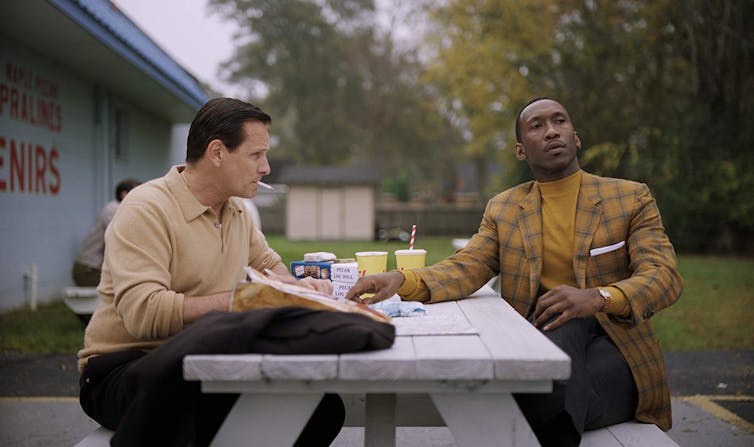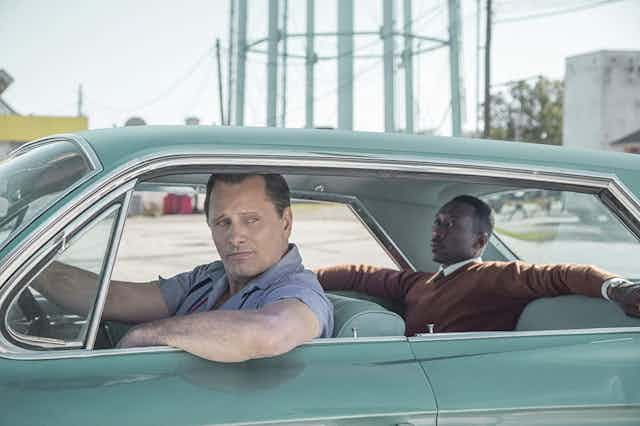Early in the Oscar-winning movie Green Book, one of the main characters paraphrases the purpose of the titular guide book given to him for his new job. It’s for “travelling while black”, explains Tony Vallelonga to his incredulous wife, Dolores. Echoing a satirical jibe in circulation today – the “crime” of “driving while black” – the film immediately draws a continuum between the racial divisions of the past and their persistence into the present.
Set in 1962, the story centres on the relationship between cultured African American concert pianist, Dr Donald Shirley (Mahershala Ali), and white working-class bouncer, Tony “Lip” Vallelonga, an Italian American (Viggo Mortensen). Hired by Shirley as a driver/bodyguard for a concert tour of America’s Deep South, Vallelonga is unrefined, quick-tempered and displays racist attitudes. The film suggests that these are a result of ignorance and constructed tribal loyalties, and thus ripe for challenge – though this is clunkily executed in places.
Long hours on the road in this interracial buddy movie lead the two men to confront each other’s prejudices on race and class. Together with situations they encounter on the trip, these experiences turn their initially distant relationship into a warmhearted and enduring friendship.
Like most historical dramas, the film has been met with questions about its accuracy. We’re told at the outset that it was inspired by a true story, and the screenplay was co-written by Vallelonga’s son Nick, a director and screenwriter, who describes researching the story with Shirley and his father. Shirley’s family, however, dispute several aspects of the film.
Staying safe
The Green Book guide, which was used from the mid-1930s to mid-1960s, was a vital aid for African Americans. Listing motels, shops, restaurants and other businesses across America – and later, other countries, too – its purpose was to mitigate the serious risk of racial violence and humiliation faced by black people while travelling.
It covered states where officially sanctioned segregation – “Jim Crow” – operated in the American South. But the guide also covered northern and other states in America, anywhere de facto segregation and racism also presented risks for black Americans – a geographical reality which is fleetingly acknowledged but not made clear here, or in many other films, which similarly focus on the South. The Green Book also reflected the upwardly mobile attitude of the wider post-war thrust in America for social mobility and consumption, particularly car ownership. For African Americans the book’s tagline: “Carry your Green Book with you … you may need it!”, only just hinted at the menace of racist encounters the guidebook was there to prevent.

Vallelonga expects “problems” to arise on the trip, but has only a vague sense of the humiliating reality of life for many African Americans. Hailing from multicultural New York and part of an established Italian American community, the argument goes, Vallelonga appears to have been shielded from the significant jeopardy suffered by black Americans.
The film’s broad brush strokes – a more racially sophisticated North versus the backward South – belie the ubiquitous reality of historic and present-day racism across the US. But it succeeds in commenting here on the absence of awareness of large parts of White America – then and now – about the true levels of racism experienced by black Americans.
The Deep South presented a terrifying risk for African Americans. Between 1877 and 1950, there were more than 4,000 racial lynchings of men, women and children in southern states – a system of terror designed to keep black citizens subservient.
Green Book’s protagonists must drive further to locate hotels where Shirley can safely stay – and we observe several other humiliations he is forced to suffer. Mistakenly straying from the Green Book’s itinerary, the travellers also drive through a “sundown town”. These were municipalities and suburbs – an astonishing 10,000 of them across the US at one point – which had successfully “removed” their black populations. Any African Americans working or passing through them had to leave by sunset.
Black stories, white directors
White directors telling stories about race are often criticised for insensitivity and racially tone-deaf filmmaking. The charge – frequently justified – is that such stories are told from a white perspective, with black characters far from the centre of their own narratives, and often drawn in a fairly one-dimensional manner. Another criticism is the “white saviour” storyline, where a white hero “saves the day” in a narrative which shrinks the central role, story and agency of black characters.
These elements are present in Green Book, but the situation is more nuanced. The film, made by white director Peter Farrelly, foregrounds the white saviour issue by making it part of the narrative. Vallelonga is employed for the very purpose of protecting his boss from trouble. Shirley has exercised agency and choice in employing this protector – one who must also carry his bags and open doors.
The requirement for a white saviour on the trip is a wider indictment of White America, which allowed racial inequality and terror to persist. And while the film is anchored around Vallelonga – we meet his family, his character experiences a far greater evolution through the narrative – Shirley’s character is also explored. A complex and brave man, his life is situated in both a public and marginal space, at the intersection of several competing narratives of identity.
The film also seeks to emphasise that a cultural conditioning of white superiority underpins both the profound racism woven into the fabric of Jim Crow, and also the racial prejudice Vallelonga exhibits at a different end of the spectrum – something he initially refutes but comes to understand.
Present imperfect
Like other historical films, Green Book uses the past to speak to the present. Today, the disproportionate numbers of non-white, particularly black citizens in the US stopped by police for traffic violations has led to the satirical charge of widespread racial profiling – “driving while black”.
The practice of stopping and seizing African Americans on the public highway has long been used in America to intimidate and restrict black people, as far back as the 1600s. Today, traffic stops can function as probable cause for further police investigation, and can be humiliating, stoke fear – and damage race relations. Minorities often feel it sends a message that they “don’t belong” – a message that chimes with a recent resurgence in hate crime and the visible rise in white power movements.
Read more: Embracing the 'silent majority' – Donald Trump brings back the worst of 1960s America
Green Book is set in the early 1960s but its resonances with the present show that, when it comes to racial harmony and equality, today’s America still has some distance to travel.

